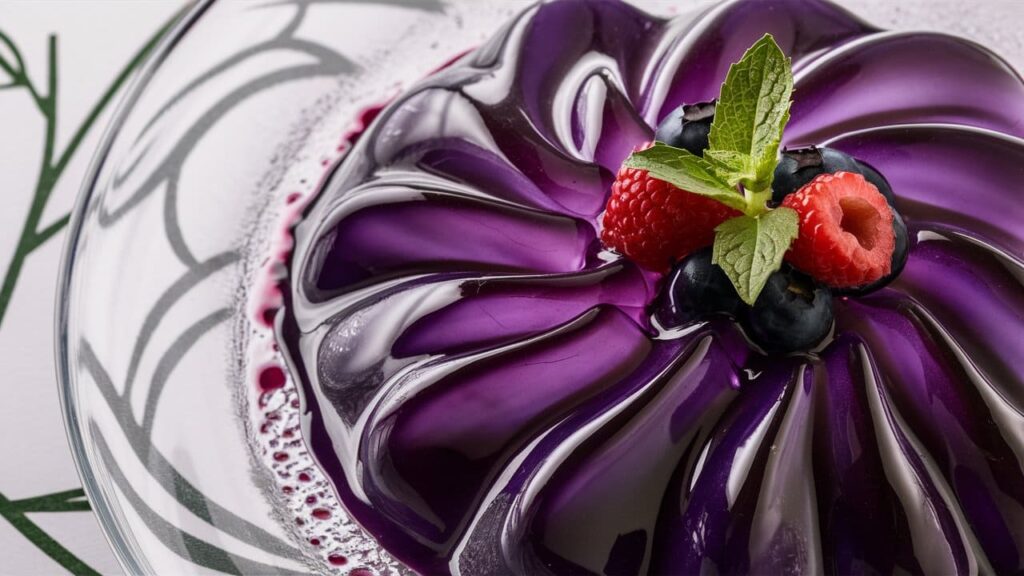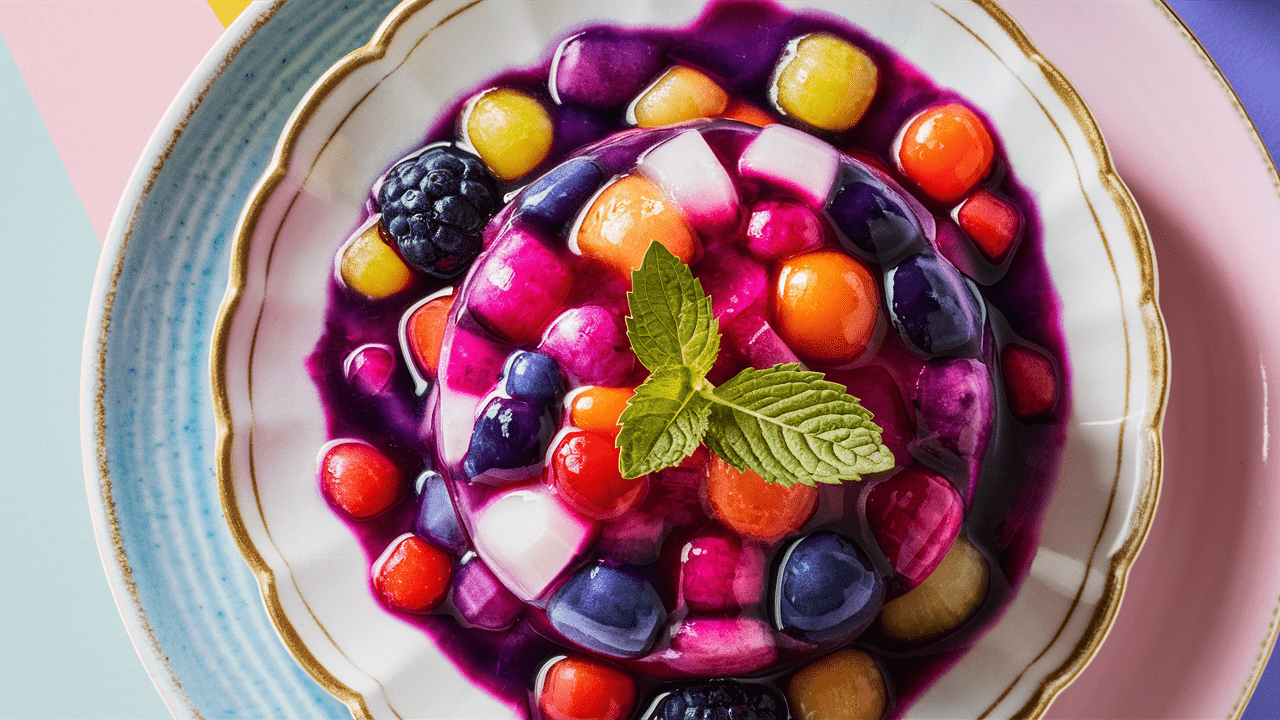Violet jelly Recipe, with its striking color and delightful floral essence, is a unique preserve that not only captures the essence of spring but also serves as a versatile condiment for many dishes. This article delves into how to prepare this exquisite jelly, exploring the ingredients, methods, and creative ways to use it.
Understanding Violet Jelly
What is Violet Jelly?
Violet jelly is a preserve made from the petals of violets, steeped to extract their vibrant color and subtle floral flavors. This jelly delights both the palate and the eyes, often adding elegance to various dishes. Its unique flavor profile makes it an excellent alternative to traditional fruit jellies.
The Health Benefits of Violets
Violets are more than just pretty flowers. They possess health benefits including:
- Vitamins: Rich in vitamin C.
- Anti-inflammatory properties: Used in herbal medicine to help with inflammation.
- Mood-enhancing effects: Believed to improve mood and reduce headaches.
Choosing and Preparing Violets for Jelly Making
To make violet jelly, use fresh, unsprayed violet flowers. The best violets for jelly are the common blue violets, often found in lawns or garden edges during spring. Once gathered, rinse the flowers gently to remove any dirt and debris and use them immediately to preserve their freshness and color.
How to Make Violet Jelly
Ingredients Needed
- Fresh violet flowers
- Water
- Lemon juice
- Sugar
- Pectin
Step-by-Step Instructions
- Extract the Essence: Steep the violet flowers in boiling water to create an infusion. Pour boiling water over the violets and allow them to steep until the water cools down, soaking up the color and flavor of the violets.
- Prepare the Jelly Mixture: Strain the petals from the liquid. Mix the resulting violet infusion with lemon juice, which changes the color from blue to a vivid pinkish-purple. Add sugar and pectin to the infusion and boil until the mixture reaches the gel stage.
- Can the Jelly: Pour the hot jelly into sterilized jars, leaving appropriate headspace.
Tips for Perfect Violet Jelly
- Proper Measurement: Ensure accurate measurements of all ingredients to maintain the balance between sweetness and tartness.
- Testing for Doneness: Use the spoon or temperature test to check if the jelly has reached its gelling point.
- Adjusting Color: The addition of lemon juice is crucial as it adjusts the pH of the jelly, which in turn enhances the color. Add gradually and adjust according to the desired hue.
Creative Uses for Violet Jelly
As a Breakfast Spread
Violet jelly Recipe is an excellent companion to morning toast or pastries. Its unique flavor enhances plain bread, croissants, or scones, providing a light, floral sweetness that is not overpowering.
In Desserts
- Cake Glaze: Use violet jelly Recipe to glaze cakes or cupcakes, adding not only flavor but also a beautiful, glossy finish.
- Macaron Filling: Incorporate it as a filling in macarons for a subtle floral note that complements the almond flavor of the cookies beautifully.
As a Gourmet Addition to Meals
- Cheese Pairing: Pairs wonderfully with soft cheeses such as Brie or goat cheese, offering a floral contrast to the creamy textures.
- Glaze for Meats: Use as a glaze for poultry or pork, providing a sweet and slightly tangy flavor that enhances the meat.
Storing and Preserving Violet Jelly
Short-Term Storage
Short-Term Storage: Keep violet jelly in the refrigerator for up to three weeks. Ensure the jar is tightly sealed to maintain freshness.
Long-Term Preservation: Process violet jelly in a water bath for long-term storage, making it shelf-stable for up to a year. Follow proper canning guidelines to ensure safe preservation.
Revitalizing Older Jelly: Gently reheat the jelly if it becomes too firm, making it easier to spread and rejuvenating its texture.
Harnessing the Unique Flavor of Violet Jelly
Pairing Violet Jelly Recipe with Beverages
Violet jelly can be more than just a spread; it’s also an excellent addition to beverages. Stir a spoonful into a hot cup of tea to add a sweet floral note, or blend it into cocktails and mocktails for a touch of elegance and a burst of color. The unique flavor of violet jelly complements both alcoholic and non-alcoholic drinks, making it a versatile ingredient in your beverage repertoire.
Enhancing Salads and Vinaigrettes
Incorporate violet jelly into dressings for fresh garden salads. A basic vinaigrette can be transformed with the addition of violet jelly, which provides a subtle sweetness and vibrant color. Mix with olive oil, vinegar, and a dash of mustard to create a dressing that is both visually appealing and delicious. This can dress up simple greens or a fruit salad, adding complexity and gourmet flair.
Baking with Violet Jelly
Violet jelly Recipe can be used as an ingredient in various baked goods:
- Thumbprint Cookies: Place a small dollop of violet jelly in the center of almond or vanilla thumbprint cookies before baking to add a floral twist.
- Layer Cakes: Spread a thin layer between cake layers for a hidden surprise that packs a punch of flavor without overwhelming the cake.
- Turnovers and Pastries: Fill turnovers or puff pastry with a mixture of cream cheese and violet jelly for a decadent treat.

Health Benefits and Nutritional Aspects of Violets
Nutritional Value of Violet Jelly
While the primary appeal of violet jelly may be its flavor and aesthetic, it also retains some of the health benefits of the violet flowers from which it is made. Violets are known for their vitamin C content, which is preserved to some extent in the jelly. This can contribute to immune system support and skin health.
Antioxidant Properties
Violets contain antioxidants that help combat oxidative stress and reduce inflammation in the body. Consuming violet jelly can contribute small amounts of these beneficial compounds, supporting overall health.
Dietary Considerations
For those monitoring their sugar intake, it’s important to consider that while violet jelly has health benefits, it is also high in sugar. However, it can be enjoyed in moderation as part of a balanced diet. Those interested in reducing sugar can explore making a low-sugar version of violet jelly Recipe using sugar substitutes that are heat-stable.
Sustainable and Ethical Foraging for Violets
Tips for Sustainable Foraging
If you choose to forage violets to make your jelly, it’s crucial to do so sustainably to ensure that the plants continue to thrive in their natural habitat:
- Forage Responsibly: Only pick flowers from areas where they are abundant. Never pick all flowers from one spot; instead, take a few from each area.
- Avoid Public Parks and Protected Areas: Many areas prohibit foraging. Always check local regulations before picking any plants or flowers.
Growing Your Own Violets
Growing violets at home can be a rewarding way to ensure a sustainable and ethical supply of this wonderful flower. Violets are relatively easy to grow and can thrive in garden beds or containers, making them accessible for a variety of living situations.
Community and Cultural Significance of Violet Jelly
Violet Jelly Recipe as a Culinary Heritage
In some regions, violet jelly is part of culinary heritage, celebrated in festivals and community gatherings. It’s a way to connect with local traditions and seasons, especially in areas where violets grow wild.
Hosting Violet-Themed Gatherings
Create a unique dining experience by hosting a violet-themed tea party or brunch. Use violet jelly as a central theme, served with scones, pastries, and tea, all adorned with edible violets to create a cohesive and elegant event.
Educational Opportunities
Teaching others about the benefits and uses of violets, as well as how to make violet jelly, can be a wonderful way to spread knowledge about this less commonly used ingredient. Workshops or cooking classes can engage community members and inspire them to explore other floral and herbal jellies.
Crafting Artisanal Jellies: The Charm of Violet Jelly
Elevating Home Cooking with Floral Jellies
Violet jelly isn’t just a preserve; it’s an artisanal addition that transforms everyday meals into gourmet experiences. Whether drizzled over desserts, stirred into cocktails, or used as a glaze for meats, this jelly introduces a sophisticated floral note that can elevate home cooking to restaurant-quality standards. Cooking with floral jellies like violet jelly encourages creativity and experimentation in the kitchen, providing a fun and delicious way to enhance both the flavor and appearance of dishes.
Pairing Violet Jelly Recipe with Other Flavors
Understanding flavor profiles that complement violet jelly can enhance your culinary creations:
- Citrus: Lemon, lime, and orange zest or juice can brighten the subtle floral notes of violet jelly, making it pop in sweet and savory dishes.
- Herbs: Mint, thyme, and rosemary can provide a fresh contrast to the sweet and floral notes of violet jelly.
- Spices: Cardamom, vanilla, and ginger pair beautifully with violet, adding warmth and depth to the jelly’s flavor profile.
The Art of Making and Using Violet Syrups
Aside from jelly, violet flowers can also be used to make syrups, which serve as a versatile ingredient in desserts, beverages, and even savory dishes. Violet syrup can be used to sweeten iced tea, flavor cocktails, or drizzle over pancakes and waffles for a sweet and floral twist. The process of making violet syrup is similar to that of jelly but requires fewer ingredients, often just violets, sugar, and water.

Promoting Health and Wellness Through Natural Ingredients
Crafting Diet-Friendly Violet Jelly Recipe Variants
For those with dietary restrictions or preferences, violet jelly can be adapted to suit various needs:
- Sugar-Free Violet Jelly: By using sugar substitutes or natural sweeteners like honey or agave, you can create a sugar-free version of violet jelly that is friendlier to those on low-sugar diets.
- Pectin-Free Violet Jelly: For those avoiding commercial pectin, apple pectin can be used as a natural alternative to achieve the desired jelly consistency.
Incorporating Violet Jelly into a Balanced Diet
While violet jelly is a sweet treat, it can fit into a balanced diet when used in moderation. Pairing it with healthy foods, such as spreading it on whole-grain bread or using it to sweeten yogurt, can incorporate its delightful flavor without compromising nutritional goals.
Sustainable Practices in Jelly Making and Flower Foraging
Foraging Ethics and Best Practices
When foraging for violets or any wild ingredients, it’s important to follow sustainable practices to protect the environment and ensure that these resources remain available for future generations. This includes:
- Foraging only in areas where plants are abundant.
- Taking only what you need and leaving enough behind for the plant population to thrive.
- Respecting wildlife habitats and natural growth cycles.
Growing Violets for Culinary Use
For those interested in a more sustainable and controlled source of violets, growing your own can be a rewarding endeavor. Violets are relatively easy to cultivate in gardens or containers, and having a personal supply can inspire regular use in your culinary experiments.
Conclusion: Rediscovering the Wonder of Violet Jelly
Violet jelly is more than just a traditional preserve; it’s a gateway to exploring the rich world of edible flowers and herbal remedies. Its unique flavor and color make it a delightful addition to any pantry, perfect for enhancing both sweet and savory dishes. Whether you are a professional chef looking to add a new dimension to your dishes or a home cook interested in expanding your culinary horizons, violet jelly offers a taste of nature’s beauty and bounty. Embrace the versatility of violet jelly and let it inspire a new approach to your cooking and wellness practices.
You can get more recipes from here:

